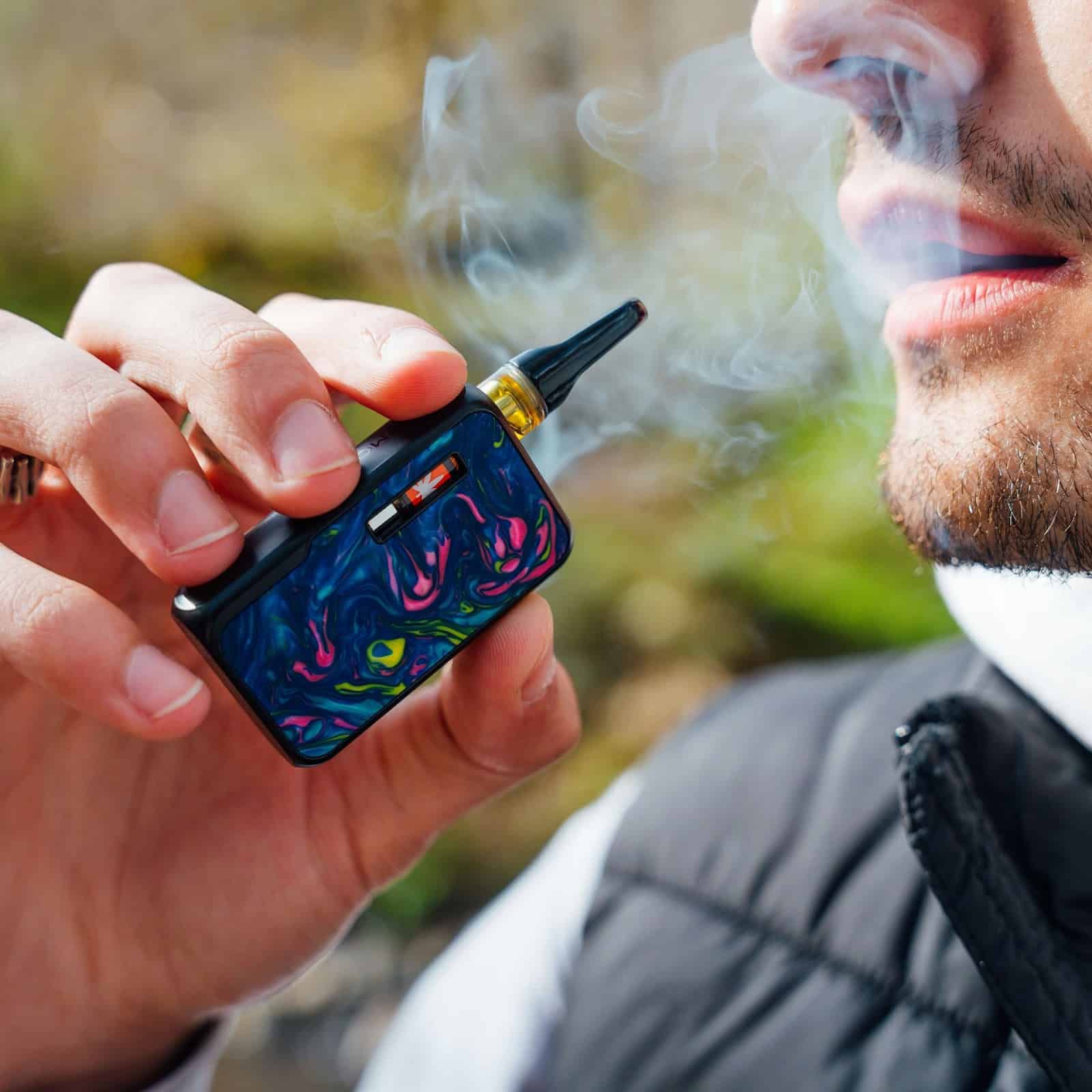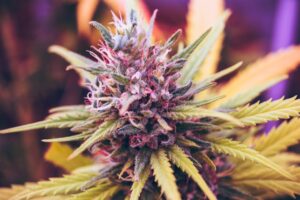Cannabis dabbing has recently gained popularity among users. This method of taking in cannabis involves smoking and vaping concentrated cannabis extracts referred to as “dabs,” which are meant to cause a potent and immediate kick-in effect. Those practicing the art of dabbing, known as dabbers, enjoy the potent flavor and effects that result from the process.
Key Takeaways
- Dabbing is the process of vaporizing cannabis concentrates to obtain a potent and flavorful experience.
- Specialized equipment is required for dabbing, which includes a dab rig and torch.
- Different cannabis concentrates possess different properties.
Exploring Cannabis Dabs and Dabbing
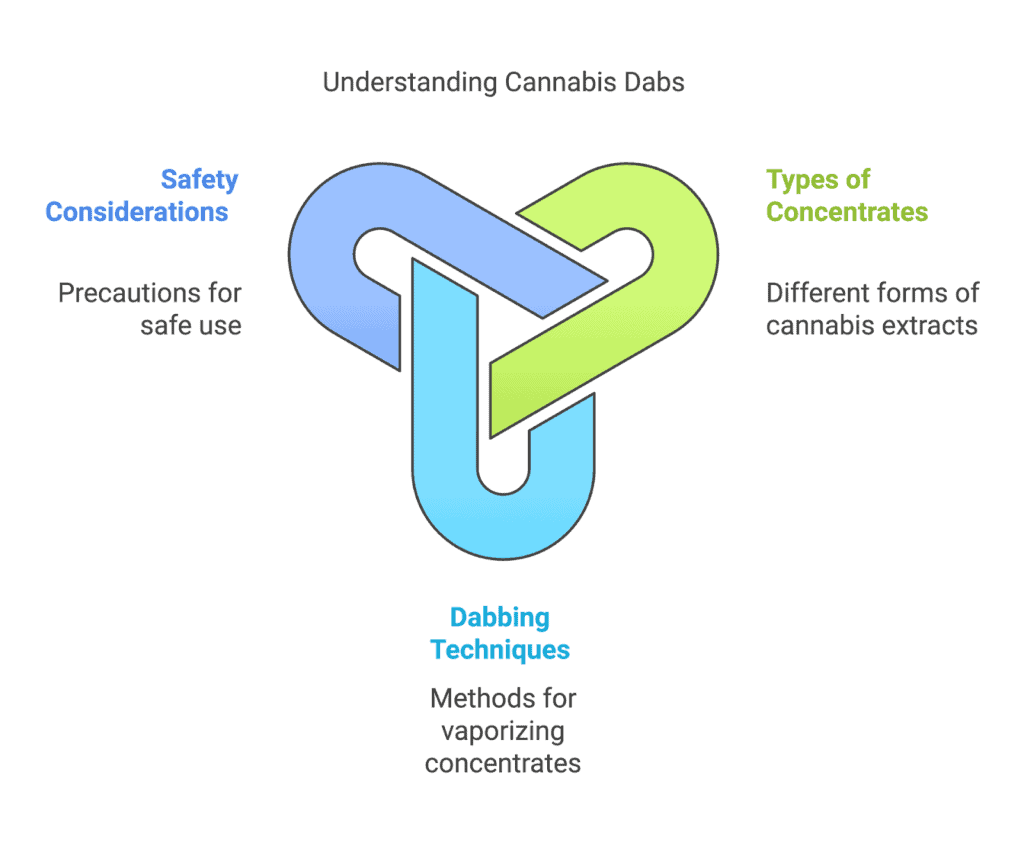
Dabbing is a strong way of consuming cannabis concentrates. Dabbing refers to the process of vaporizing concentrated THC extracts to create an instant, intense high. Let’s get into dabs and dabbing.
The Basics of Dabbing
Dabbing is the inhalation of vaporized cannabis concentrates. You heat a small amount of concentrate on a hot surface, usually a nail, and inhale the resulting vapor. This method delivers an intense high because of the concentrated THC content.
Dabs are much stronger than traditional cannabis flower. The effects hit you quickly and can be quite intense. It’s important to start with tiny amounts, especially if you’re new to dabbing.
The process requires specialized equipment, including a dab rig, nail, and torch. You’ll also need a dab tool to handle the sticky concentrates.
Different Types of Cannabis Concentrates
Cannabis concentrates come in various forms, each with unique properties:
- Shatter: Glassy and fragile, breaks easily
- Wax: Soft, pliable, like candle wax
- Butter: Consistency is buttery.
- Rosin: Heat and pressure extracted with no solvent
- Butane Hash Oil (BHO): Use butane as a solvent.
These concentrates differ in both potency, flavor, and consistency. Some are far easier to work with than others, so choose one you feel comfortable with.
Equipment Essentials: Dab Rigs and Tools
To dab, you’ll need
- Dab rig: a water pipe designed for concentrates
- Nail: the heating element, typically quartz, titanium, or ceramic
- Torch: used to heat the nail
- Dab tool: used to place concentrate on the hot nail
- Carb cap: helps in regulating airflow and temperature.
Optional items are:
- E-nail: an electric heating element to give accurate temperature control
- Dab mat: used to protect surfaces from spills and messes.
Select good-quality equipment for the best dabbing experience. Keep your rig and tools clean regularly to preserve flavor and prevent buildup.
Dabbing Technique and the User Experience
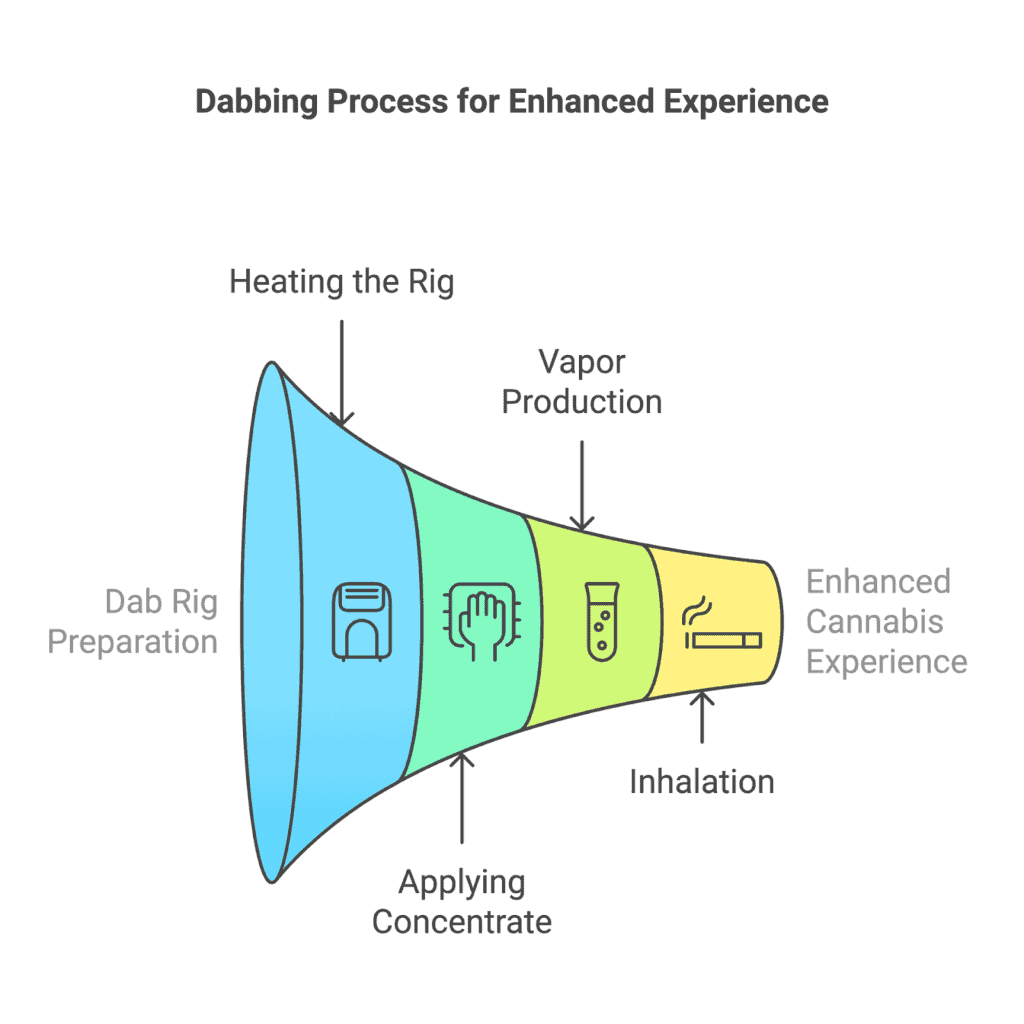
Dabbing cannabis concentrates provides a potent high through vaporization. Special equipment and proper technique are required to get the most effects with the least risks.
How to Dab: Step-by-Step
To dab, you’ll need a dab rig, torch, nail, and concentrate. Heat the nail with the torch until it’s red-hot. Let it cool for about 30-45 seconds. Use a dabber tool to place a small amount of concentrate on the nail. Inhale slowly as the concentrate vaporizes. Cap the nail to capture remaining vapor.
Begin with minuscule dabs—little goes a long way. The smoke is harsh, so start out hitting it really small. You should clean your nail between dabs for the best flavor and effects. With experience you will be able to get your temperature and dose to where it is optimal for you.
The Psychological and Physical Effects of Dabbing
It hits you fast and hard. You will feel an intense feeling of euphoria and cerebral high within a few seconds. The effect is much stronger than when smoking flower. You might experience the following effects:
- Extreme relaxation Heightened sensory perception
- Altered time sense Increased appetite Dry mouth and red eyes
Dabbing can be very potent in decreasing pain, nausea, and anxiety. However, the high can be too strong for the new user. Start slow to determine your tolerance.
Safety and Risks Associated with Dabbing
Dabbing presents some unique risks. Extreme temperatures and equipment can be hazardous, causing burns. Inhaling large amounts of concentrated THC can cause such things as:
• High heart rate
• Paranoia or anxiety
• Dizziness and fainting
• Hallucinations
There’s also a risk of dependence with frequent use. Dabbing can quickly spike your tolerance, making it harder to get high from other methods.
Always buy concentrates from reputable sources to avoid contaminants. Never attempt to make your own extracts at home—it’s extremely dangerous.
Terminology and Cultural Aspects of Dabbing
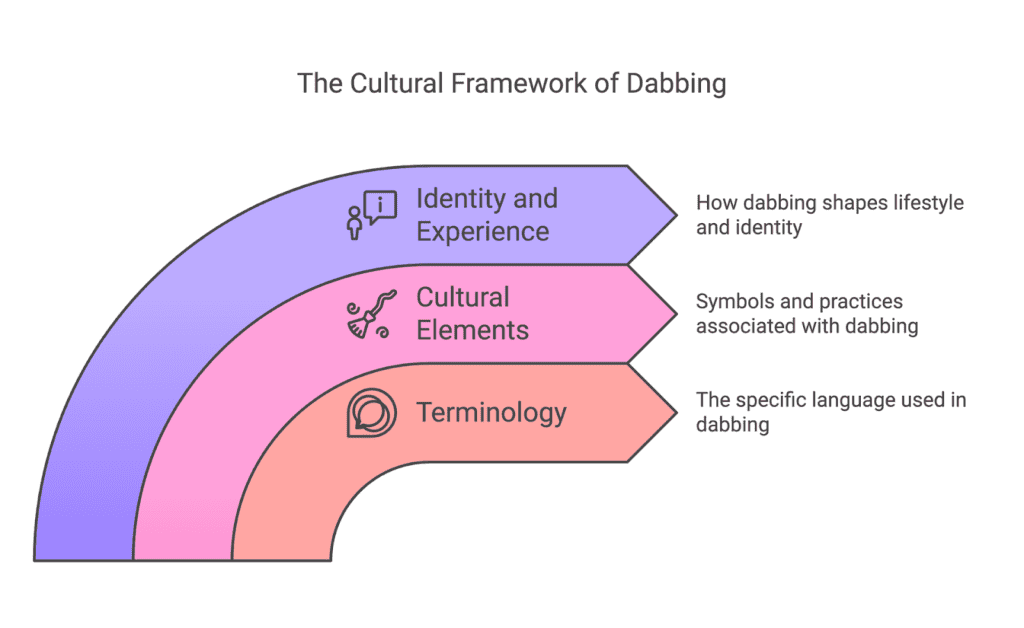
Dabbing has developed its own unique lingo and cultural significance within cannabis communities and beyond. You’ll find a mix of slang terms and pop culture references associated with this potent consumption method.
Dabber Lingo and Definitions
As a dabber, you’ll want to get familiar with some key terms. “Dab” refers to the concentrated cannabis extract you’re consuming. You might hear it called wax, shatter, or budder depending on its consistency.
The tool you use to vaporize your dab is a “rig” or “dab rig.” It’s similar to a bong but designed specifically for concentrates. You’ll heat the “nail” or “banger”—the” part where you place your dab.
“Low-temp” and “high-temp” describe different dabbing techniques. Low-temp dabs preserve more flavor, while high-temp hits pack a stronger punch.
Dabbing in Pop Culture and Beyond
You probably know what the “dab” dance move is, popularized by the hip-hop artists Migos. This has nothing to do with cannabis use but shares the name and has become a part of the mainstream culture.
In the cannabis community, being a “dabber” is sometimes a badge of honor when it comes to experienced consumption. You may find dabbers trading tips at dispensaries or competing in “dab competitions” to show off their skills.
Dabbing culture has primarily been spread through social media. You can get many videos of people dabbing and even reviewing products on Instagram and YouTube.
Extraction and Production of Dabs
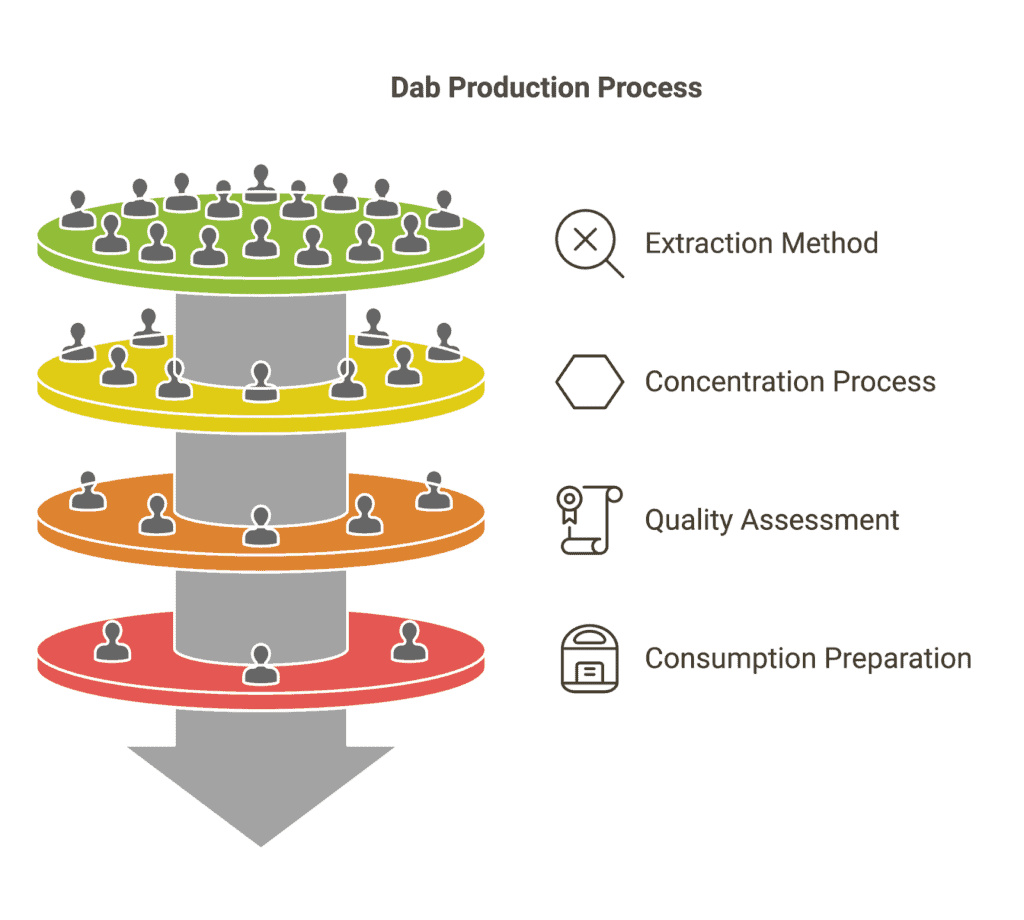
Dabs are an extremely concentrated cannabis extract received through various extraction methods that separate cannabinoids and terpenes from plant material, resulting in highly concentrated products.
Extraction Methods: Solvents vs. Solventless
You’ll find two main approaches to making dabs: solvent-based and solventless extraction. Solvent methods use chemicals like butane or CO2 to strip cannabinoids from plant matter. Butane hash oil (BHO) is popular, where butane pulls out the good stuff, leaving behind a sticky concentrate.
Chemical-free, solventless methods avoid chemicals completely. They work instead using pressure, heat, or agitation. Consider your ice water hash or any form of rosin pressing. These might be much safer for the DIYer but yield much less product.
Quality and Safety: Purity and Contamination Concerns
Pureness is what you want in dabs—to have clean, potent concentrates without nasty extras. Residual chemicals from the extraction process can remain if they are not purged well. That is why lab testing is so important.
Beware of pesticides and mold. These can concentrate in the extraction process and might make dabs worse than flower. Only purchase from reputable sources that have test results to back them up.
Home production? Be extra careful. Without proper equipment and know-how, you might end up with a contaminated or unsafe product. It’s often safer to leave extraction to the pros.
Frequently Asked Questions
What effects does dabbing have on the brain?
Dabbing can create an extremely potent high in the shortest amount of time possible. You may feel euphoria, relaxation, and altered perception. Some people report increased creativity or focus. Be aware that the potency can also lead to stronger side effects like anxiety or paranoia in some people.
How does dab wax differ from traditional cannabis?
Dab wax is a super-concentrated cannabis product. It contains much more THC than flower, usually 60-90%, whereas flower is 15-25%. The texture is waxy or crumbly. You use it differently too—smoking tiny amounts rather than smoking larger quantities of plant material.
What should you look for when buying a dab rig?
Quality of materials, like borosilicate glass, should be sought. Joints should fit snugly. A solid base prevents toppling. Size matters; smaller rigs preserve flavor better. Cooling the vapor can be facilitated by percolators. Don’t forget the must-haves: a quartz banger or titanium nail and a carb cap.
How do dabs compare to wax concentrates?
There are two varieties of cannabis concentrates, dabs and wax. Dabs usually refer to BHO extracts like shatter or budder. Wax is softer and more opaque. Both are extremely potent, but dabs are sometimes a little more refined.
What’s the difference between a dab pen and a vape pen?
Dab pens are concentrated cannabis-specific pens. Concentrate pens have stronger batteries and coils that help burn thick oils. Vape pens are very versatile and can be used for e-liquids or thinner cannabis oils. Generally, dab pens tend to produce bigger clouds and have stronger effects.
Is there a specific name for a device used to consume dabs?
The most frequently used equipment is referred to as a dab rig. The device has a lot in common with a bong but is specifically designed for extracting concentrates into vapor. Also known as oil rigs, wax rigs, or even concentration pipes. Portable equipment like dab pens or nectar collectors each provides another dabbing experience.

